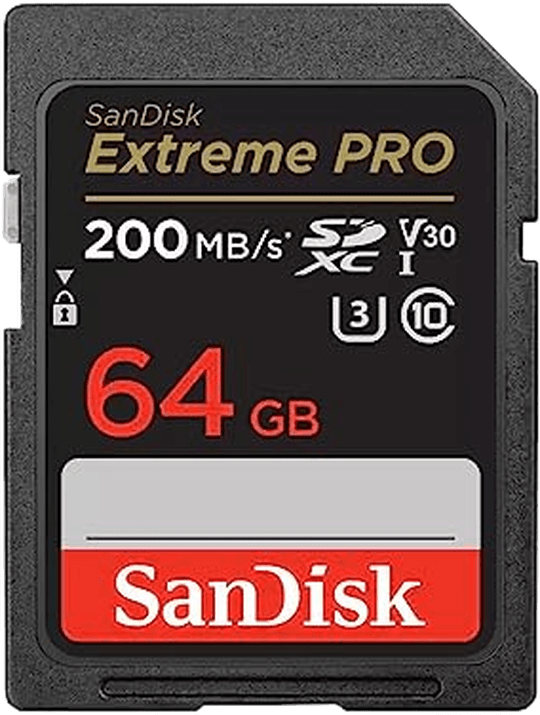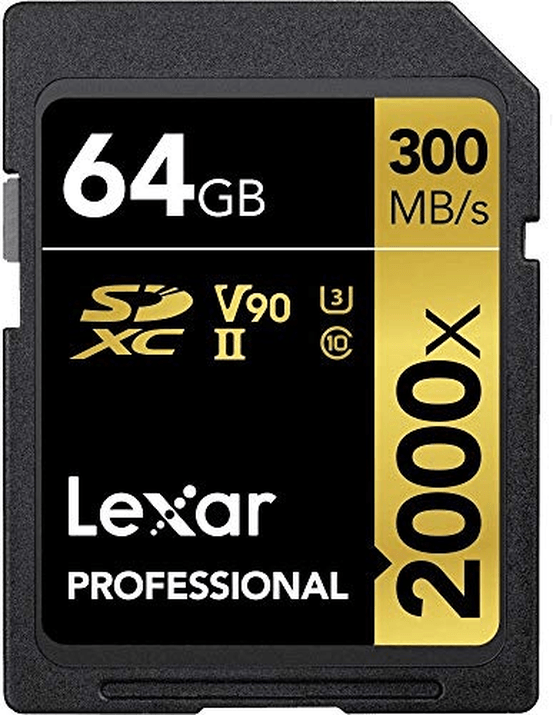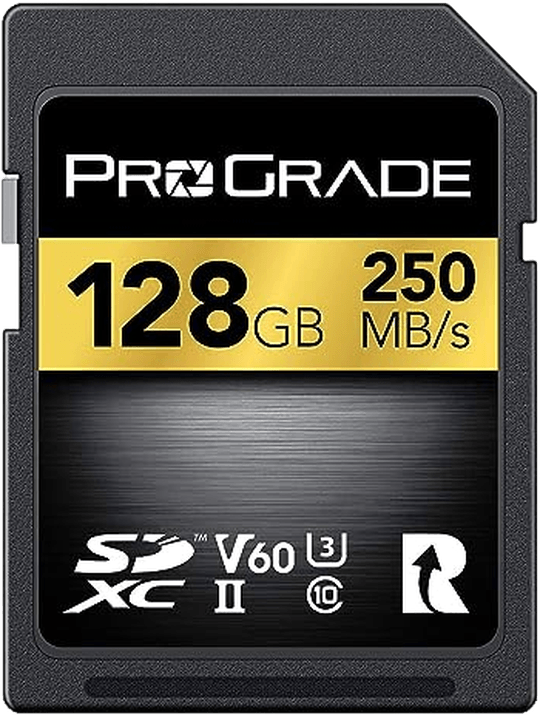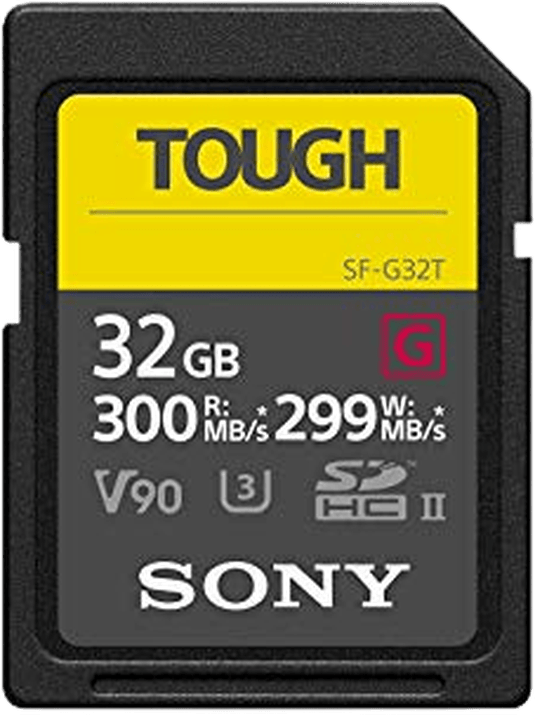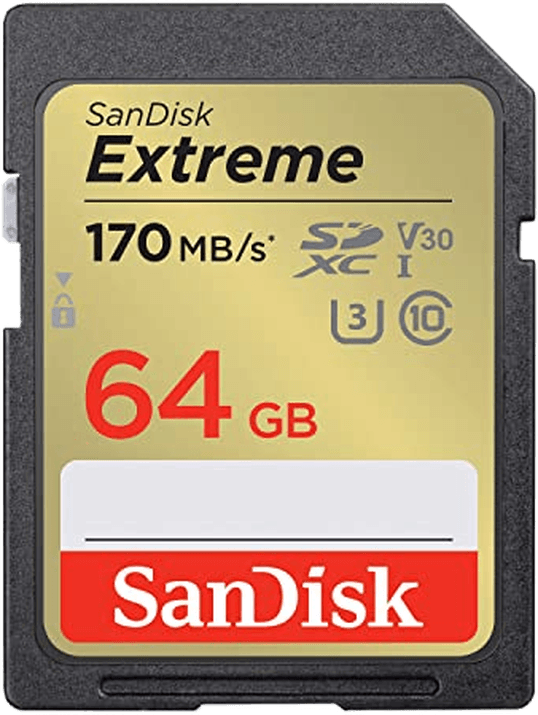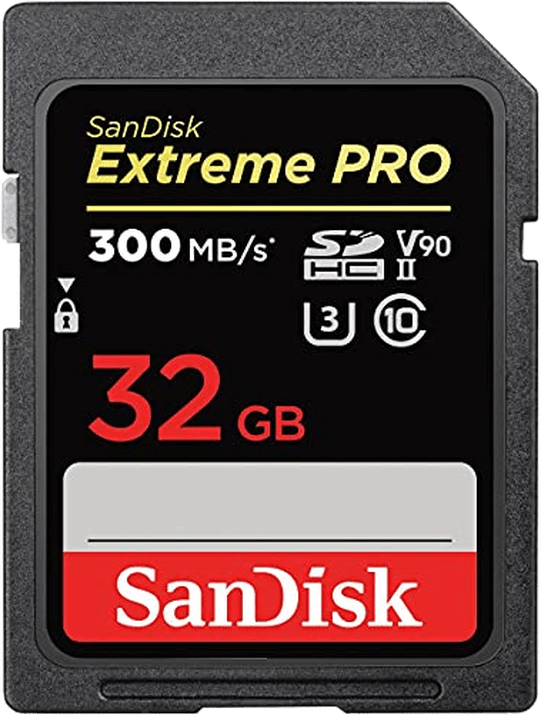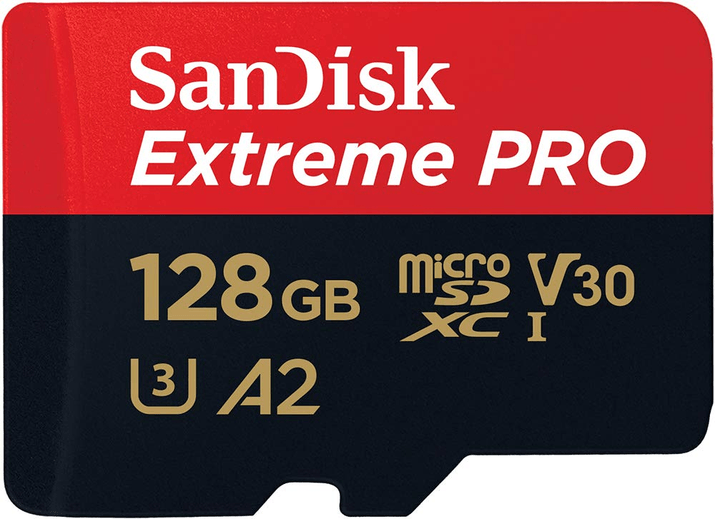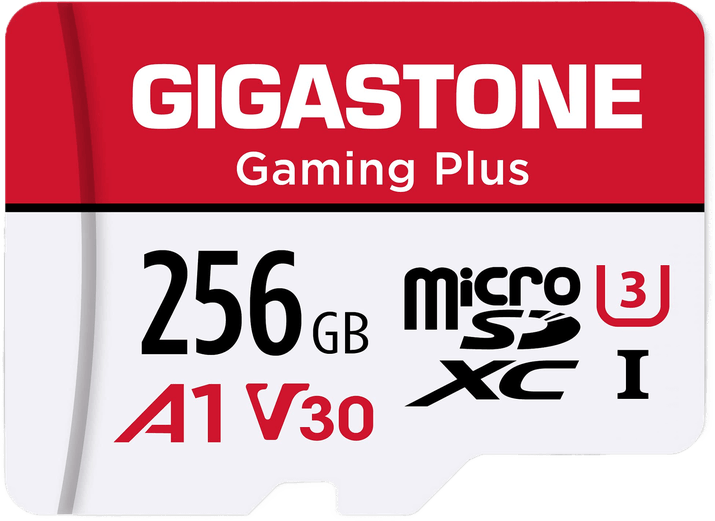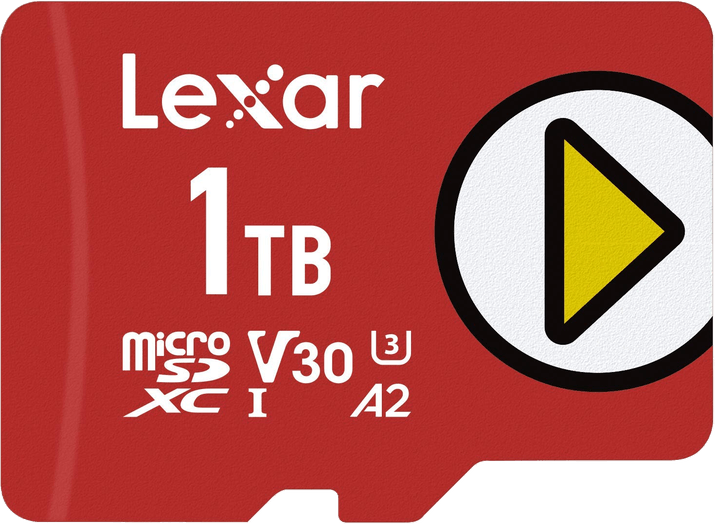The technology boom has provided us with the best SD cards in the last few years. Gone are the days of the digital camera feeling like an extended roll of film. Our memory cards can store many more photographs compared to the 36 frames you would get from a 35mm roll of film.
But with so many SD cards out there, what should you consider? Today, we’ll look at the best SD and microSD cards over a range of budgets. If you’re simply after our top choice, go with a SanDisk Extreme Pro SD card. It’s well-priced, reliable, and has a durable construction. So it’s the best SD card for a budding photographer.
Our Top 3 Choices for The Best SD Card
SanDisk 64GB Extreme PRO UHS-I SDXC Memory Card
SanDisk 64GB Extreme PRO UHS-I SDXC Memory Card
Lexar Professional 2000x 64GB SDXC UHS-II Card
Lexar Professional 2000x 64GB SDXC UHS-II Card
ProGrade UHS-II 128GB SD Card
ProGrade UHS-II 128GB SD Card
What is the Best SD Card?
Here are the 10 best SD cards for you to consider. I’m listing seven regular-sized SD cards and three microSD cards. Use the links below to jump to the table that’s right for you. Or jump to the end to learn some of the key elements to look for when looking for the best SD card,
- Best SD Cards
- Best MicroSD Cards
Our Top Choice
SanDisk 64GB Extreme PRO SDXC UHS-I Card
SanDisk 64GB Extreme PRO SDXC UHS-I Card
-
Fast speeds for a great price
-
Six different size options available
-
Capture uninterrupted video with UHS Speed Class 3 (U3) and video Speed Class 30 (V30)
-
Built for and tested in harsh conditions
Best Lexar Choice
Lexar Professional 2000x 64GB SDXC UHS-II Card
Lexar Professional 2000x 64GB SDXC UHS-II Card
-
Extremely fast SD card for a low price
-
Backwards compatible with UHS-I device
-
A reliable brand for over 15 years
-
Suits both amateurs and professionals
Best Recovery Options
ProGrade UHS-II 128GB SD Card
ProGrade UHS-II 128GB SD Card
-
Advanced professional recovery software
-
Fast speeds up to professional standards
-
Up to standard with modern video abilities
-
Each memory card has a custom engraved number to help prevent theft
Most Durable
Sony Tough 32GB SD Card
Sony Tough 32GB SD Card
-
World's first one-piece constructed SD card
-
Less parts that are easy to break
-
Backward compatible with UHS-I compatible equipment
-
Waterproof design
Great Value
SanDisk Ultra 64GB Class 10 SDXC UHS-I Memory Card
SanDisk Ultra 64GB Class 10 SDXC UHS-I Memory Card
-
Great speeds for a low price
-
Best for compact or point-and-shoot cameras
-
Reliable SD card to have in your kit
-
Exceptional video-recording performance with class 10 rating for Full HD video
Highly Recommended
SanDisk 64GB Extreme SDXC UHS-I Memory Card
SanDisk 64GB Extreme SDXC UHS-I Memory Card
-
Engineered with technology to reach speeds beyond UHS-I 104 Mbps
-
Pairs with the SanDisk Professional Pro-Reader SD for maximum speeds
-
A great backup card for professionals
-
Perfect for shooting 4K Ultra HD (UHD) video and burst mode photography
Most Powerful
SanDisk 32GB Extreme PRO SDHC UHS-II Memory Card
SanDisk 32GB Extreme PRO SDHC UHS-II Memory Card
-
Superfast write speeds of up to 260 Mbps
-
Designed for professional and advanced photographers and videographers
-
Shockproof, temperature-proof, waterproof, and X-ray-proof design
-
Can handle cinema-quality 8K, 4K and Full HD video recording
Best SD Cards
|
Brand |
Brand
SanDisk
|
|
Size |
Size
32, 64, 128, 256, 512 GB, 1 TB
|
|
Flash Memory Type |
Flash Memory Type
SDXC
|
|
Max Transfer Speed |
Max Transfer Speed
170 Mbps
|
|
Best For |
Best For
Photographers looking for a reliable memory card
|
SanDisk has earned a trusted reputation in the photography industry. They provide a wide range of specs, making it easier for you to find the best SD card. Out of all their memory cards, the best ones are in their lineup of Extreme Pro cards.
With a write speed of 90 Mbps, it handles any DSLR camera offering multiple ranges of burst modes. It also writes to a V30 standard, meaning it can record in 4K. It also provides a read speed of 170 Mbps.
As this is in the industry standard range of SD cards, the price is competitive. I’ve chosen this 64 GB version to give you plenty of images for a fair price. There is a 32 GB version that’s s a bit cheaper. But I’ve learned it’s better to be safe than sorry.
The Extreme Pro range also offers a UHS-II version. It has a superfast write speed of 260 Mbps. So you can smash out the most demanding jobs, like shooting 8K, cinema-quality video. Of course, this comes with a hefty price tag.
If you’re not using these for intensive processing jobs, you can get the cheaper UHS-1 cards. You won’t notice the difference.
|
Brand |
Brand
Lexar
|
|
Size |
Size
32, 64, 128, 256 GB
|
|
Flash Memory Type |
Flash Memory Type
SDXC
|
|
Max Transfer Speed |
Max Transfer Speed
300 Mbps
|
|
Best For |
Best For
Videographers or professional photographers
|
Lexar SD cards are more expensive. Their higher price is because they dominate the speed game in the world of SD cards. But when you compare their specs to other brands, you realize they’re great for the price. The
Lexar UHS-II card offers superfast speeds for less than most.
Boasting write speeds of 260 Mbps and a read speed of 300 Mbps, you won’t be checking your watch as the images pour in. But again, this is not noticeable from the UHS-I range of cards with a small number of images. So it may not be worth the money if you want to save a couple of seconds on the upload times.
Only certain cameras can take full advantage of this card’s most significant capabilities. So be sure to check if your camera is one. If not, and you still love this card, Lexar provides “backward compatibility.” This feature means you can use it in other cameras. And it performs at the highest possible level the camera can.
|
Brand |
Brand
ProGrade
|
|
Size |
Size
128, 256 GB
|
|
Flash Memory Type |
Flash Memory Type
SDXC
|
|
Max Transfer Speed |
Max Transfer Speed
250 Mbps
|
|
Best For |
Best For
Photographers who want recovery options
|
Another top competitor in the SD market is the ProGrade line of memory cards. The
ProGrade UHS-II card has the lowest price of its kind. But it does not achieve the blinding speeds provided by other brands. The lower speed is redeemed, though. The card delivers UHS-II capabilities to most full frame cameras.
And with insanely fast write speeds of 130 Mbps and read speeds of 250 Mbps, there’s no way you could say this card is slow. ProGrade provides more than enough power for amateur and professional photographers alike.
ProGrade also advertises its advanced
Recovery Pro 3.0 software.
Recovery software can be a lifesaver when disaster strikes. To have a company that provides this service is essential—that’s why most do. (But to be constantly working on and developing this software is a different story. So you can consider this when comparing SD cards.)
|
Brand |
Brand
Sony
|
|
Size |
Size
32, 64, 128 GB
|
|
Flash Memory Type |
Flash Memory Type
SDXC
|
|
Max Transfer Speed |
Max Transfer Speed
300 Mbps
|
|
Best For |
Best For
Photographers who work in unfriendly environments
|
Sony has taken the role of completely redesigning the SD card for the rugged explorers out there. They introduced the Tough series, first released in 2020. With innovations in design, these could be pioneers for SD cards in the future.
They are the first company to remove the ribs between the connectors. This allows for added durability. Adjustments like this have led to Sony’s claims of having the world’s most demanding SD card. And
Sony Tough cards boast 18 times more bending resistance than regular SD cards.
If you have a camera compatible with UHS-II, V90, you get read speeds of 300 Mbps and write speeds of 299 Mbps. Sony puts your mind at ease with these incredible speeds. It allows professionals in the field to have one less thing to worry about.
|
Brand |
Brand
SanDisk
|
|
Size |
Size
16, 32, 64, 128 GB
|
|
Flash Memory Type |
Flash Memory Type
Micro SDXC
|
|
Max Transfer Speed |
Max Transfer Speed
80 Mbps
|
|
Best For |
Best For
Photographers on a budget
|
The SanDisk Ultra range is the best entry-level SD card. This range covers all your photographic DSLR needs, from basic images to Full HD 1080p video. The price will have you jumping for joy and contemplating buying a few, which is always a good idea.
The
Ultra UHS-I SD card provides a read speed of 80 Mbps and a write speed of at least 10 Mbps. This doesn’t mean that the card is slow. But you don’t want to get a card that is slower than this.
For photographers who aren’t taking pictures daily, it won’t take many minutes out of your day. And for professionals, this is the perfect card to have one or two around as an emergency backup.
|
Brand |
Brand
SanDisk
|
|
Size |
Size
32, 64, 128, 256, 512 GB
|
|
Flash Memory Type |
Flash Memory Type
SDXC
|
|
Max Transfer Speed |
Max Transfer Speed
170 Mbps
|
|
Best For |
Best For
Amateur photographers
|
This is the memory card we recommend for amateurs and professionals. It’s for those who want fast read-and-write speeds but don’t need high-end cards. I use the
SanDisk Extreme UHS-1. And it hits the sweet spot of being fast, having a lot of space, and being relatively cheap.
With write speeds of up to 80 Mbps and read speeds of 170 Mbps, you won’t need much higher if you’re shooting photos. And even if you’re filming a video, this SD card can capture full 4K quality.
You can get this type of SD card up to 256 GB if needed. I had contemplated going for the full 256 GB card. But 128 GB is plenty for me. I didn’t waste the extra money on space I wouldn’t often use. I have had no issue with this card and haven’t reached its capacity on any jobs either.
|
Brand |
Brand
SanDisk
|
|
Size |
Size
32, 64, 128, 256 GB
|
|
Flash Memory Type |
Flash Memory Type
SDHC
|
|
Max Transfer Speed |
Max Transfer Speed
300 Mbps
|
|
Best For |
Best For
Videographers or long exposure photography
|
The SanDisk Extreme Pro range is the top range that SanDisk produces. The
Extreme Pro UHS-II is the more expensive version in the same range that tops our leaderboard. Everyday photographers don’t really need this card’s extra speed. Regular SD cards still perform at great speeds. I suggest this card for videographers or those who work with
long exposures.
This is one of the best SD cards on the market. It’s at the bottom of our SD list because there are cheaper UHS-II cards. But SanDisk is a reliable brand. So if you have had corrupted memory cards before, you may want to play it safe with this one.
Best MicroSD Cards
Our Top Choice
SanDisk 128GB Extreme PRO microSD UHS-I Card
SanDisk 128GB Extreme PRO microSD UHS-I Card
-
Write speeds of up to 140 Mbps
-
Durable design for use in extreme environments
-
Gives you faster app performance in smartphones
-
Great for capturing 4K Ultra HD (UHD) video
Top Rated
Gigastone 256GB Micro SD Card
Gigastone 256GB Micro SD Card
-
Wide compatibility across a range of devices
-
Comes with 5-year limited warranty including free data recovery
-
Provides faster app-loading performance for smartphones and tablets
-
Waterproof, shockproof, temperature-proof and X-ray proof
Most Memory
Lexar PLAY 1TB microSDXC UHS-I Card
Lexar PLAY 1TB microSDXC UHS-I Card
-
Huge amounts of memory for such a small memory card
-
Fast transfer speeds for quick loading time
-
Compatible with Nintendo Switch, portable gaming devices, smartphones, and tablets
-
Loads apps faster with A2-rated performance
MicroSD cards are rare in DSLR cameras. You will find them in digital
point-and-shoot cameras or drones. But you can still use a microSD card on cameras through an adapter. This may be helpful as their size means you can carry them anywhere. Let’s review the best microSD cards out there.
|
Brand |
Brand
SanDisk
|
|
Size |
Size
128 GB
|
|
Flash Memory Type |
Flash Memory Type
Micro SDXC
|
|
Max Transfer Speed |
Max Transfer Speed
200 Mbps
|
|
Best For |
Best For
Compact cameras
|
Of course, SanDisk produces great SD cards of this size as well. Its top-of-the-range microSD is the
SanDisk Extreme Pro UH-S1. This memory card packs a punch with a read speed of 170 Mbps and a write speed of 90 Mbps. It beats the regular Extreme range that SanDisk offers.
As you pay less due to its size, it’s worth investing in a good microSD card. This is particularly true for phones that shoot 4K videos.
If you don’t want to worry about taking up space, SanDisk produces a range of up to
1 TB. 64 GB will do well for most pieces of equipment. But it’s worth considering how often you want to format (erase) your cards. We’ve chosen the 128 GB for some extra space.
Like a regular SD card, Sandisk does have
a cheaper microSD range. Read and write speeds aren’t as crucial for some microSD devices. So saving some money on a cheaper option could be worth it.
2. Gigastone 4K Camera Pro
|
Brand |
Brand
Gigastone
|
|
Size |
Size
256 GB
|
|
Flash Memory Type |
Flash Memory Type
Micro SDXC
|
|
Max Transfer Speed |
Max Transfer Speed
200 Mbps
|
|
Best For |
Best For
Action and video cameras
|
Gigastone has produced a
4K Camera Pro micro SD card. It’s specifically geared toward shooting 4K videos. And it’s best suited for compact video cameras that produce high-quality video. For example, it is the perfect memory card if you own a GoPro!
It can read at speeds of 100 Mbps and write at 60 Mbps. This makes it a great microSD that performs to professional standards. The Gigastone brand also continues to develop its technology in memory cards. So you can feel confident having one of these in your video camera.
|
Brand |
Brand
Lexar
|
|
Size |
Size
256 GB
|
|
Flash Memory Type |
Flash Memory Type
Micro SDXC
|
|
Max Transfer Speed |
Max Transfer Speed
100 Mbps
|
|
Best For |
Best For
Photographers who need max space in a microSD
|
If capacity is your aim, Lexar offers the best
1TB microSD option. The Play title of this range of cards speaks of its fit for gaming. The card is built for use with the Nintendo Switch or other handheld devices.
But it still works on any device that takes a microSD card. This card is for you if you shoot lots of photos and videos on your
camera phone.
The price is on the cheaper end for this size. If we look at the cost-to-performance ratio, this one comes out on top. It reads at 150 Mbps, and it’s not just size but the power that makes it so good. So if you need the most space but don’t want it to be slow, look no further.
SD Card Features
The most common form of memory card in the modern day is the SD card. SD stands for Secure Digital. It was released in 1999 and has become the industry standard. Let’s first discuss the aspects you should look for when comparing SD memory cards.
SD Memory Card Capacity
The essential quality of a memory card is how many pictures it can hold. Capacity is commonly measured in gigabytes (GB) but can stretch to terabytes (TB). You can split SD cards into two different types:
- SDHC (Secure Digital High Capacity)
- SDXC (Secure Digital eXtended Capacity)
SDHC cards cover the capacity range of around 4 to 32 GB. SDXCs start from 64 GB and can go up to an astounding 2 TB. Choosing the capacity of your card is all about what you need the SD card for.
- Benefits of Large Storage: Some types of photography have fleeting moments, such as photojournalism or wedding photography. Here, you want an SD card with a bigger capacity. It gives you more time to take photos before changing your memory card. It can potentially save you a couple of valuable seconds. Bigger memory cards are also useful if you don’t like constantly uploading images. They can be for people who use the cards for simple point-and-shoot pictures. Or they can be for photographers taking pictures in remote places for long periods. They allow you to shoot for days, if not weeks if you use up all the space on the memory card.
- Benefits of Small Storage: A smaller-capacity SD card can be good if you aren’t shooting endless photos. Smaller SD cards can be more convenient. You can create a streamlined method of taking photos. And you can store different events on different cards. This method makes it easier to sort your material onto the computer.
Instead of buying large memory cards where you don’t use much of the space, smaller ones will save you a bit of money. The less space, the lower the price.
SD Memory Card Speed
There are two different speed specs for memory cards that you want to look at—the write speed and the read speed:
- Write Speeds: This refers to how quickly a memory card can process an image you take in your camera. The write speed can be an essential factor to keep in mind. Pretty much any modern SD card has enough speed for the average photographer. But when it comes to more specialist uses, this can be something to keep in mind. For instance, some cameras only allow a high-range burst mode if the memory card is fast enough. It’s also evident when making long exposures. The quicker the write speed, the quicker you see your photo on the camera. Action, sports, and wildlife photographers who use high burst speeds will want this… videographers, too, who shoot 4k or higher.
- Read Speeds: This is referred to as the transfer speed. This is the speed that determines how fast a file takes to get from card to computer. The rate is measured in megabytes per second (Mbps). As you may have guessed, the higher the number, the slower the upload time. If you want to transfer files superfast, you can also check out our review of the best SD card readers.
Conclusion
SD and microSD cards are all about storage space and read-write speed. With such advanced technology, you don’t have to spend much if you are a beginner or enthusiast. There is no point in paying for the best SD card if it doesn’t affect your workflow.
It’s all about identifying what you will use your camera for. Check your camera’s manual to see if you need a faster write speed for burst mode. Or if you’re an astrophotographer or videographer, you may want fast write speeds, too.
If you’re looking for a great SD card at a great price, go with our top choice. It’s well-priced, reliable, and durable… And from experience, I have learned to always take more than one SD card when taking photos. So make sure you buy more than one!
Our Top 3 Choices for The Best SD Card
SanDisk 64GB Extreme PRO UHS-I SDXC Memory Card
SanDisk 64GB Extreme PRO UHS-I SDXC Memory Card
Lexar Professional 2000x 64GB SDXC UHS-II Card
Lexar Professional 2000x 64GB SDXC UHS-II Card
ProGrade UHS-II 128GB SD Card
ProGrade UHS-II 128GB SD Card
